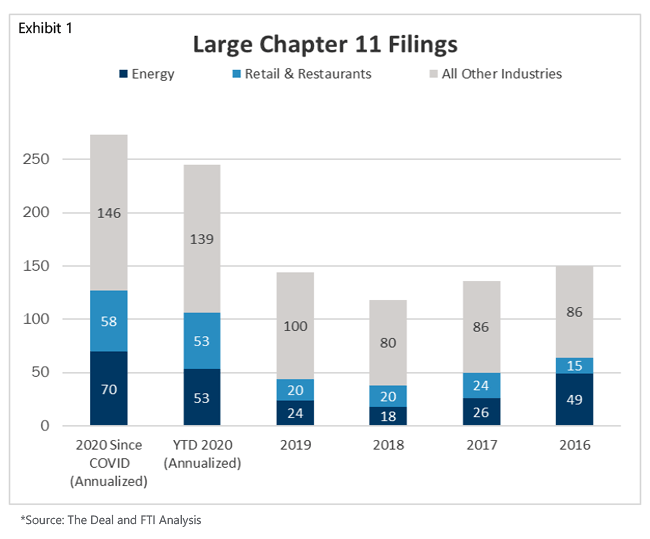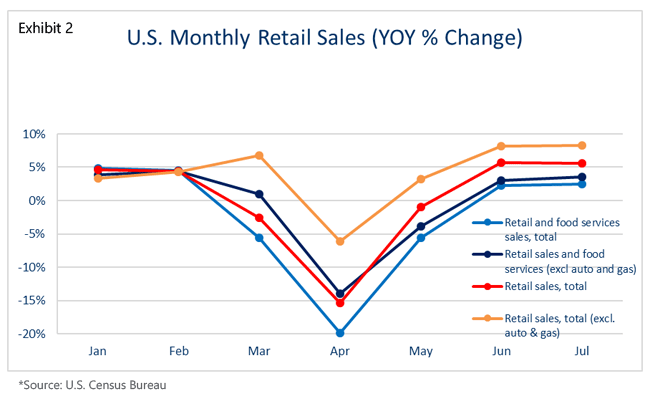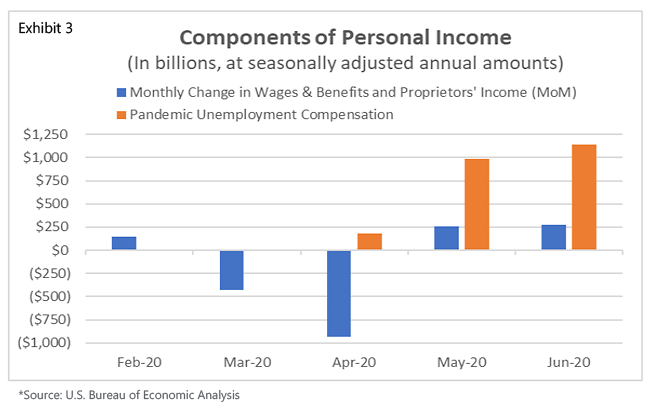
While financial markets continue to party like it’s 1999 (quite literally), the restructuring market is looking more like 2009 with each passing month. This scenario was inconceivable just a few months ago, but the unrelenting monthly toll of filings and defaults since the arrival of COVID-19 now leaves us with the impression that the sharp upturn in events of corporate failure has staying power beyond the duration of the pandemic.
In June we commented that annual filings would likely exceed 200 in 2020 compared to 144 in 2019, but it now seems that 250 is within sight (Exhibit 1) given another strong month for filings in July—a total that would begin to rival the 300 filings racked up during the Great Recession of 2008-2009.

The retail and energy sectors continue to lead the charge, as they have for several years—collectively accounting for 46% of large Chapter 11 filings since COVID struck here. For retailers, the pandemic and accompanying shutdown have been the final blow for many struggling store-based businesses, as millions of housebound consumers migrate further to the online channel for their shopping needs.
Financial markets could hardly care less about the surge in retail bankruptcies and store closings and are focused on the bigger picture—resurgent growth in retail sales. Many market commentators and economists point to robust retail sales in recent months as the most compelling evidence of a V-shaped recovery.
It’s true that aggregate retail sales have posted year-over-year gains for three straight months after cratering in March and April (Exhibit 2), meaning that the retail sector is one of the few industries to have fully rebounded from the pandemic’s initial impact. (However, spending patterns among retail segments is another story.)

Some of this growth is attributable to reduced consumer outlays on experiences since the pandemic, such as travel & leisure, concerts and movies, which has redirected spending towards hard goods and consumables. This spending shift doesn’t diminish recent retail gains, but it means that they likely won’t be sustainable once folks are more comfortable circulating again. Furthermore, there is a big catch behind the surprising comeback in retail sales since May, and the unexpected strength of consumer spending in the aggregate (including online) in the face of the most abrupt and severe recession in post-War history merits further discussion and closer scrutiny.
What goes largely undiscussed in this comeback story is the huge impact of extremely generous unemployment benefits on consumer spending—financial relief that is exceedingly costly to taxpayers and will likely be curtailed going forward. While statisticians may debate over the proper measurement of the unemployment rate and the degree to which the Labor Department may have undercounted the unemployed since the pandemic hit, one grim fact is indisputable: Some 28 million Americans filed to receive state and/or federal unemployment benefits at the end of July compared to 1.7 million a year earlier. This is a staggeringly large number that represents nearly 18% of the U.S. workforce.(1)
To counter the immediate impact of the shutdown on laid off and furloughed workers, the federal government enacted the Pandemic Unemployment Compensation program (PUC) as part of the CARES Act legislation passed in late March, which provided $600 weekly to unemployed Americans, as well as Pandemic Unemployment Assistance (PUA) for nearly 11 million jobless gig workers and independent contractors who don’t qualify for state unemployment benefits. (2)
Moreover, some 16 million Americans continued to receive both state and federal unemployment benefits in late July. PUC and PUA were meant to be a temporary stopgap measures of financial relief for individuals intended to prevent a collapse of the economy as the shutdown was implemented across large sections of the country. PUC was scheduled to expire at the end of July, at which point the economy was expected to be getting back on its feet, while PUA will continue until year end. Once the economy reopened, it was anticipated that most furloughed workers would be recalled to their jobs and the need for such extraordinary relief would quickly diminish. It hasn’t exactly worked out that way judging from recent unemployment insurance claims, with hopes that most furloughed and otherwise idled workers will be recalled or reemployed seeming more unrealistic each month.
The PUC, PUA and PEUC programs (note that there are three of them) are well-intentioned but exorbitantly costly for taxpayers. Data for May and June from the U.S. Bureau of Economic Analysis (BEA) pegs their annualized cost at just over $1 trillion, or roughly 22% of the entire federal budget in 2019. Total unemployment compensation accounted for 7.1% of U.S. personal income in June compared to less than 0.5% in January through March. Moreover, BEA data also reveals that amounts spent on pandemic unemployment in May and June far exceeded the decline in wages & benefits and proprietors’ income between March and June (Exhibit 3), underscoring the programs’ huge cost and perhaps calling into question its largesse.

But for nearly 30 million Americans, pandemic unemployment remains a lifeline that may be holding off financial ruin. For retail businesses, this financial relief for individuals has been a significant contributor to the consumer spending rebound they so badly needed. Much of the $75-$80 billion per month paid out under these programs has been pumped back into the economy by recipients. Should the PUC program not be extended, its impact on consumer spending will be felt immediately. Retail sales growth in August slowed notably from the previous two months and missed most economists’ expectations. It is a wrenching dilemma for policymakers.
Consequently, the extension of PUC has become a hotly contested issue in Congress as part of the next phase of pandemic relief, with Democrats strongly urging a full extension of PUC at least through year end or into 2021 and Republicans mostly balking at an extension of the full $600 weekly benefit as well as any lengthy extension of the program, arguing that the generosity of PUC combined with state unemployment benefits are creating disincentives to return to work. (Indeed, there are credible studies indicating that a substantial percentage of unemployed Americans are receiving more in financial relief than their previous jobs were paying.) President Trump has indicated a willingness to support an extension of PUC but at a reduced weekly amount. PUC expired as scheduled in late July, as Congress was unable to agree on the next phase of pandemic relief before it adjourned in August. The issue will likely be taken up again by Congress before the election.
So here we are at a critical impasse for the recovery. Financial markets are assuming that the Trump administration and Congress eventually will do whatever it takes or costs to keep the nascent recovery moving along, especially as the election nears, and that will continue to benefit the consumer-facing corporate sector. Neither party wants to be blamed for the financial hardship that will ensue for millions of voting Americans if PUC is not extended. It seems safe to assume that some compromise will be reached that both parties can live with going into November. But they too are just kicking the can down the road.
A large percentage of Americans keep telling pollsters they will not be resuming their pre-COVID lives or lifestyles for quite a while even if the pandemic subsides. This will translate into a protracted period of abnormally high unemployment and dislocation for much of the work force. We will be having this conversation again in December or March or whenever the next extension of PUC will be scheduled to expire. The current course of action may be averting near term disaster, but it is unsustainable over the longer run.
1. https://www.dol.gov/sites/dolgov/files/OPA/newsreleases/ui-claims/20201406.pdf
2. https://www.dol.gov/newsroom/releases/eta/eta20200404